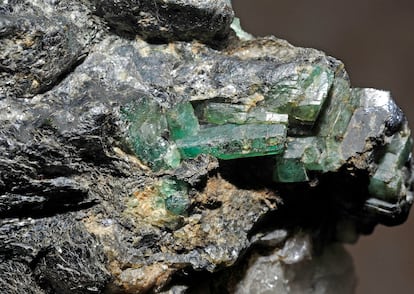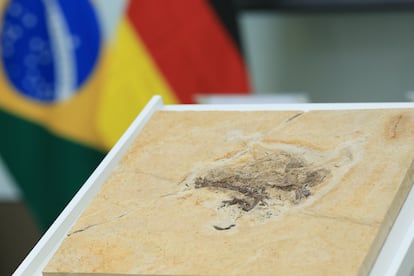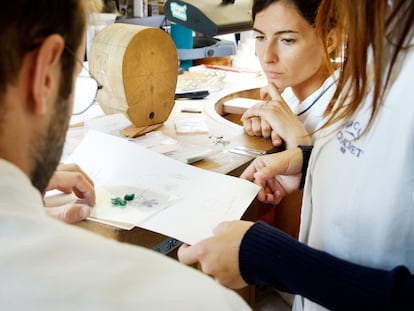The ‘Bahia Emerald’: The story of a giant cursed gem stolen from Brazil
A US judge has authorized the repatriation of the 837 lb gem, valued at hundreds of millions of dollars


One of the largest emeralds to be excavated from a mine in Brazil’s Bahia region at the start of this century, the ‘Bahia Emerald,’ has been under L.A. police protection for the past 10 years. In the photos you can see the crystals, embedded in a blackish stone. They are bright green and you can guess at their hexagonal shape.
The Bahia Emerald is a rare and valuable piece that can be summed up in figures: 380 kilos (837 pounds), 180,000 carats. And it is so exotic that estimates of its worth range from between $370 million and $920 million. The giant gem was taken out of Brazil under false pretenses and eventually confiscated in Las Vegas. It remains in safekeeping while the U.S. justice system resolves the long litigation involving the Brazilian State, individuals and U.S. companies, all of whom claim ownership. At the end of November, a federal judge ruled in favor of Brazil and authorized the gem to be repatriated, but there is room for appeal.
Since its discovery in 2001, the life of the Bahia Emerald has been nothing if not eventful. Excavated from a mine in the Carnaíba mountain range, 400 kilometers (248 miles) inland from Salvador, where five other giant emeralds have been discovered this century, it has earned a reputation for being cursed.
It passed through numerous hands, sometimes in shady transactions, until two Brazilians took it out of the country in 2005. They got it out by claiming it was asphalt stone and natural bitumen. Declared value? $100. Next stop, the United States. That same year the emerald survived Hurricane Katrina, which flooded the warehouse where it was stored.
That year it was sold to the highest bidder on eBay for $19 million, according to Wired magazine. But the transaction never went through. Over the years, the plot thickened: sales at different prices, a fake kidnapping, the use of the emerald as collateral in a diamond sale... In 2008, thanks to a tip-off, the police confiscated the Bahia Emerald in an operation in Las Vegas, complete with special forces and a helicopter. Since then, it has been at the center of a judicial battle.
Innumerable Bahia emeralds have passed through the hands of the gemologist Monica Correa, but not the Bahia Emerald. She has only seen it in photos. The black mineral in which the precious crystals are embedded is called biotite, she explains. She works with polished pieces for jewelry rather than with the rough stones that attract collectors because of their exuberance and size. “If you look at this one, you can even see the hexagon shape that emerald crystals have in their natural state,” says Correa, who works at the Gemological Center of Bahia, in Salvador, where she analyzes the purity of gemstones for certification.
If the Bahia Emerald is returned to Brazil, it would mark a milestone in the country’s battle to recover pieces plundered centuries ago. Last May, Denmark returned an invaluable piece of indigenous art, also from Bahia, to the National Museum of Rio de Janeiro: a very delicate red feather cape sewn by the Tupinambá Indians that had been in the Danish royal collection since 1689. In 2023, Germany’s National Museum of Natural History in Karlsruhe returned the Ubirajara jubatus, the fossil of a dinosaur that lived 110 million years ago in Ceará, which has become the most famous in Brazil thanks to a successful campaign on social media to demand its return from Germany.

The case of the Bahia Emerald is as convoluted as a Brazilian soap opera with any number of protagonists, entanglements, betrayals and a plot that is hard to follow. For years, a number of individuals and companies claiming ownership have been fighting it out in the U.S. courts, represented by a large army of law firms. The courts have recognized that some of them acted in good faith and were deceived, but none of them have been recognized as having the right to ownership.
On November 21, U.S. federal judge Reggie Walton ruled in favor of the Brazilian state, which has also been immersed in a legal battle to recover what it considers a national treasure. Lawyers for the Brazilian Public Prosecutor’s Office adopted a novel strategy, according to Reuters: they called on their U.S. colleagues to comply with the bilateral agreement committing them to enforce Brazilian rulings. The Brazilian magistrate who convicted those who removed the stone from Brazil in 2017 also demanded that it be repatriated. Now Judge Walton has ruled that this be complied with.
The Carnaíba mountain range is considered the Brazilian capital of emeralds. It was 1963 when a farmer who was clearing stubble from his field came across some shiny green stones. He handed them over to the authorities. In no time, the news that there were emeralds in the interior of Bahia spread far and wide. An army of garimpeiros (artisanal miners) promptly appeared to mine the earth, according to Jornal Correio. It was full steam ahead until the end of the 1970s, when the miners came up against an impassable quartz plate.
It was in the 1980s when news of a new emerald deposit in Goiás, 1,500 kilometers (932 miles) to the west, reached Pindobaçu and other cities in the highlands, and off the miners went. Some perhaps even became rich, but the most valuable thing for the Bahian garimpeiros was to learn about technological advances from their colleagues in Goiás. They learned to dig beyond the quartz plate. And, of course, they went back home immediately with this knowledge to extract the precious stones from the interior of Bahia.
Organized into a cooperative since 2006, some 600 miners work in the municipality’s 81 deposits. Last year, they extracted 400 tons of the stone in which the precious green gems are embedded. But the biggest prize is the Bahia Emerald ‘sisters.’ Six have been discovered in 25 years. The last one, just recently, in September.
It is not unreasonable to think that if Brazil manages to recover the Bahia Emerald, one option would be to hand it over to the Geological Museum of Bahia, in Salvador. But the museologist Elizandra Pinheiro says that no one has contacted them to discuss this possibility. Beyond its multi-million-dollar price tag, the emerald has an enormous patrimonial value.
“It represents a historical context: the garimpeira community, an economic activity that passes from generation to generation,” explains Pinheiro, who points out that Bahia has already had its diamond, gold and emerald rushes. The museum, which exhibits the rich geological heritage of the state in the form of meteorites and fossils, is also a research center. In 2025, it will be half a century old. Who knows if, in a new unexpected twist in this long saga, it will become home to the cursed Bahia Emerald.
Sign up for our weekly newsletter to get more English-language news coverage from EL PAÍS USA Edition
Tu suscripción se está usando en otro dispositivo
¿Quieres añadir otro usuario a tu suscripción?
Si continúas leyendo en este dispositivo, no se podrá leer en el otro.
FlechaTu suscripción se está usando en otro dispositivo y solo puedes acceder a EL PAÍS desde un dispositivo a la vez.
Si quieres compartir tu cuenta, cambia tu suscripción a la modalidad Premium, así podrás añadir otro usuario. Cada uno accederá con su propia cuenta de email, lo que os permitirá personalizar vuestra experiencia en EL PAÍS.
¿Tienes una suscripción de empresa? Accede aquí para contratar más cuentas.
En el caso de no saber quién está usando tu cuenta, te recomendamos cambiar tu contraseña aquí.
Si decides continuar compartiendo tu cuenta, este mensaje se mostrará en tu dispositivo y en el de la otra persona que está usando tu cuenta de forma indefinida, afectando a tu experiencia de lectura. Puedes consultar aquí los términos y condiciones de la suscripción digital.
More information
Archived In
Últimas noticias
ChatGPT fails the test: This is how it endangers the lives of minors
The late consecration of women artists in their 90s
The Florida Keys tourist paradise is besieged by immigration agents: ‘We’ve never seen anything like this’
The latest scam on WhatsApp behind the legal dream: using immigration status as bait
Most viewed
- Families demand repatriation of bodies of Colombians who died in Ukraine: ‘This war is a slaughterhouse for foreigners’
- The low-cost creative revolution: How technology is making art accessible to everyone
- Liset Menéndez de la Prida, neuroscientist: ‘It’s not normal to constantly seek pleasure; it’s important to be bored, to be calm’
- Christian Louboutin: ‘Young people don’t want to be like their parents. And if their parents wear sneakers, they’re going to look for something else’
- ‘El Limones’ and the growing union disguise of Mexican organized crime









































